Layman D. Biology Demystified: A Self-Teaching Guide
Подождите немного. Документ загружается.


1. A plant is:
(a) A multicellular organism that develops from an embryo, contains
chlorophyll, and produces energy by photosynthesis
(b) Seldom found associated with fungi or animals
(c) Solely engaged in only the process of photosynthesis, nothing else
(d) A heterotrophic organism that gains most of its nutrition by
feeding off the decaying bodies of others
2. The vascular plants:
(a) Typically are without any true leaves, stems, or roots
(b) Include the mosses and other moss-like plants
(c) Contain no hollow ducts within their tissues
(d) Are alternately called the tracheophytes
3. A bryophyte is technically:
(a) A vascular plant without true leaves
(b) A ‘‘tree moss plant’’
(c) Some kind of seedless plants without leaf veins
(d) Related closer to the slime molds than to other plants
4. Hepatica:
(a) Is a low-growing plant with lobed leaves resembling the liver
(b) Can be easily compared to a muscle in the lower leg
(c) Commonly grows to over 100 feet in height
(d) Usually lives on dry, wind-swept mountaintops
5. The main group of seedless vascular plants:
(a) Oak trees
(b) Mildews and slime molds
(c) Ferns with fronds
(d) Gymnosperm flowers
6. The vascular plants with ‘‘naked’’ seeds:
(a) Sperms
(b) Gymnosperms
(c) Angiosperms
(d) Ovas
7. Pine cones produce spores by the process called:
(a) Symbiosis
(b) Evolutionary adaptation
(c) Protective camouflage
(d) Meiosis
CHAPTER 9 Plants: Kings and Queens 157
[13:24 13/6/03 N:/4058 LAYMAN.751/4058-Alltext.3d] Ref: 4058 Layman: Biology Demystified All-text Page: 157 1-388

8. A cloud of pollen is really:
(a) Millions of microspores that have developed into male gametes
(b) Thousands of megaspores ready to be fertilized
(c) A pair of ovules within a female scale
(d) A female cone that exploded accidentally
9. The male reproductive organ of a flower:
(a) Carpel
(b) Stamen
(c) Stigma þ style
(d) Ovary
10. Dicots are flowering plants that:
(a) Contain only one small cup or hollow in their seeds as a beginning
embryo
(b) Include corn plants, grasses, lilies, palm trees, and irises
(c) Enclose a pair of hollow embryos within each of their seeds
(d) Bloom only in the desert
The Giraffe ORDER TABLE for Chapter 9
(Key Text Facts About Biological Order Within An Organism)
1. ____________________________________________________________
2. ____________________________________________________________
3. ____________________________________________________________
4. ____________________________________________________________
5. ____________________________________________________________
[13:24 13/6/03 N:/4058 LAYMAN.751/4058-Alltext.3d] Ref: 4058 Layman: Biology Demystified All-text Page: 158 1-388
PART 3 Five Kingdoms of Life, plus Viruses
158
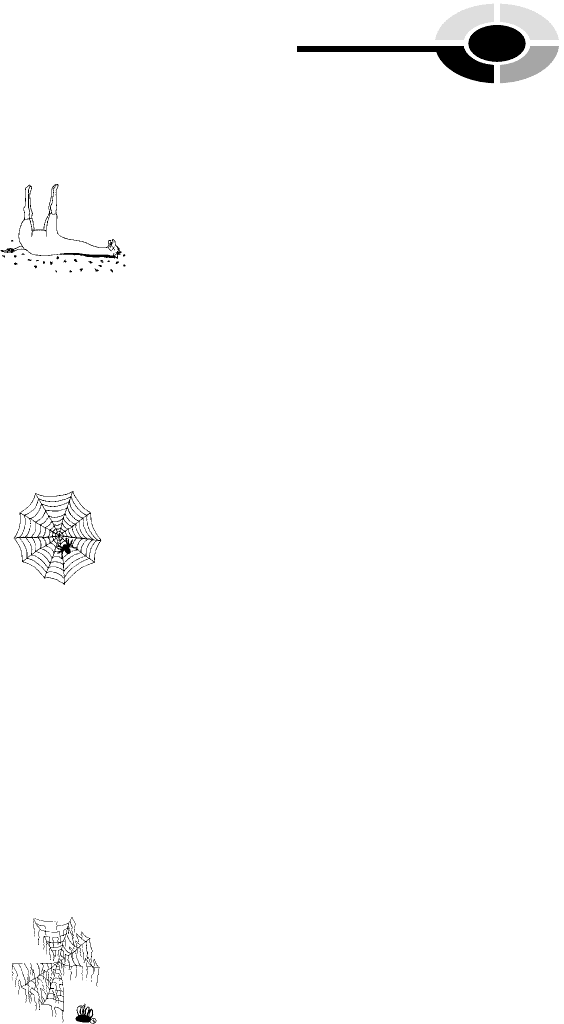
The Dead Giraffe DISORDER TABLE for Chapter 9
(Key Text Facts About Biological Disorder Within An Organism)
1. ____________________________________________________________
The Spider Web ORDER TABLE for Chapter 9
(Key Text Facts About Biological Order Beyond The Individual
Organism)
1. ____________________________________________________________
2. ____________________________________________________________
3. ____________________________________________________________
4. ____________________________________________________________
5. ____________________________________________________________
The Broken Spider Web DISORDER TABLE for Chapter 9
(Key Text Facts About Biological Disorder Beyond The Individual
Organism)
1. ____________________________________________________________
CHAPTER 9 Plants: Kings and Queens 159
[13:24 13/6/03 N:/4058 LAYMAN.751/4058-Alltext.3d] Ref: 4058 Layman: Biology Demystified All-text Page: 159 1-388
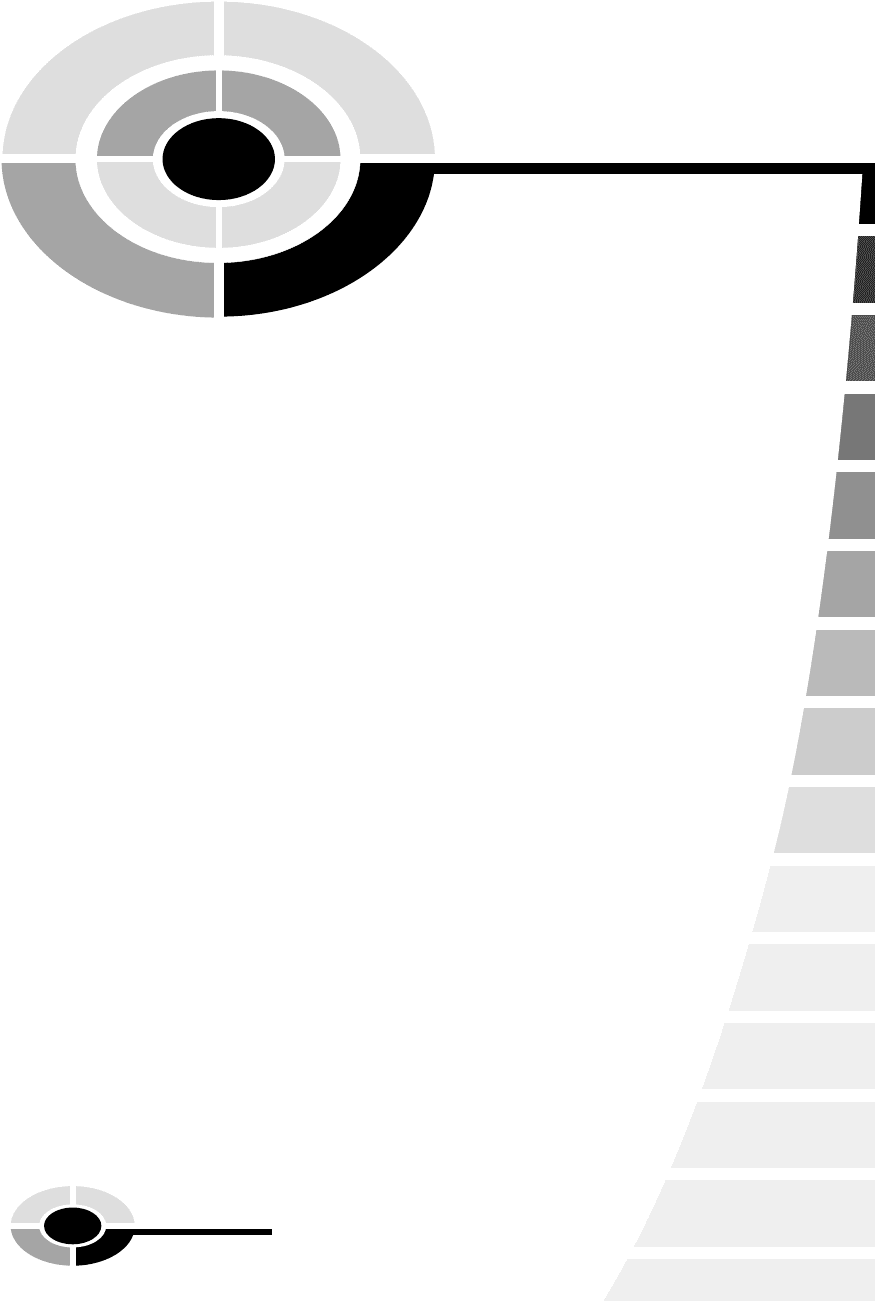
[13:24 13/6/03 N:/4058 LAYMAN.751/4058-Alltext.3d] Ref: 4058 Layman: Biology Demystified All-text Page: 160 1-388
CHAPTER
10
Invertebrates As
Special Animals:
‘‘Have You No
Spine?’’
The last few chapters have featured relatively simple organisms, such as the
bacteria, slime molds, and fungi. And Chapter 9 considered plants in detail.
Now, with Chapter 10, we begin to move beyond plants and simple organ-
isms and explore the Exciting World of Animals!
You may remember (Chapter 3) that an animal is any ‘‘living, breathing’’
(anima) multicellular organism that is neither a plant nor a fungus. We
further label all animals as heterotrophs, in that they must eat other organ-
isms or organic matter to obtain energy for their survival. Finally, all animals
are eukaryotes, because their cells contain nuclei.
160
Copyright 2003 by The McGraw-Hill Companies, Inc. Click Here for Terms of Use.

The Invertebrates: Animals without Backbones
Chapter 3 also pointed out that there are two broad types of animals – the
vertebrates (animals with backbones) and the invertebrates (animals without
backbones). We are discussing the invertebrates, first, because they are the
older group and the first to appear in the Fossil Record.
There are several ways in which invertebrate animals can be subdivided
into different main types or groups: for example, according to whether true
body tissues are present or according to the overall pattern of body form.
PRESENCE OR LACK OF TRUE BODY TISSUES
Recall (Chapter 2) that a tissue is a collection of living cells, plus the inter-
cellular material located in the spaces between them. Most invertebrates (and
other animals) contain true body tissues: i.e., collections of similar cells that
are specialized to perform only certain body functions. Epithelial tissues, for
example, are collections of cells specialized for covering and lining body
parts, while connective tissues help strap or link different body parts together.
This main group of animals are technically called the eumetazoans (yew-met-
uh-ZOH-ahns). The eumetazoans are literally the ‘‘animals’’ (-zoans) that
contain ‘‘true’’ (eu-) tissues that are formed ‘‘after’’ (meta-) repeated cell divi-
sion in the embryo. Both a starfish and a lobster, for instance, contain specia-
lized tissues playing particular roles in different parts of their bodies. Hardened
epithelial tissue covers the tough, horny back of the lobster, whereas the soft
muscle tissue (commonly eaten by humans) lies within its body and legs.
The other main group of animals are the parazoans (pair-uh-ZOH-ahns).
The parazoans are a small group of invertebrates that literally lie ‘‘beside’’
(para-) most other ‘‘animals,’’ not quite belonging. The parazoans lack true
tissues. This makes them basically different from the eumetazoan animals
with tissues. The primary living examples of parazoa are the sponges
(Figure 10.1). Sponges are members of the Phylum Porifera (poor-IF-er-
ah), because their bodies are full of ‘‘pores’’ or holes. Sponges are usually
stationary animals attached to the ocean floor. They consist of tube-like or
wider vase-like colonies of cells having some specialization, but not enough
to create individual tissues. Cells with flagella help sweep large quantities of
seawater in through pores along the sides of the sponge. The flagellated cells
are called collar cells. As the nutrient-rich seawater is swept in, food particles
are caught within the sticky mucus in the oval collar of tiny branches located
at the base of the flagellum. The particles are then ingested by phagocytosis.
CHAPTER 10 Invertebrates 161
[13:24 13/6/03 N:/4058 LAYMAN.751/4058-Alltext.3d] Ref: 4058 Layman: Biology Demystified All-text Page: 161 1-388
1, Web
2, Web
3, Web
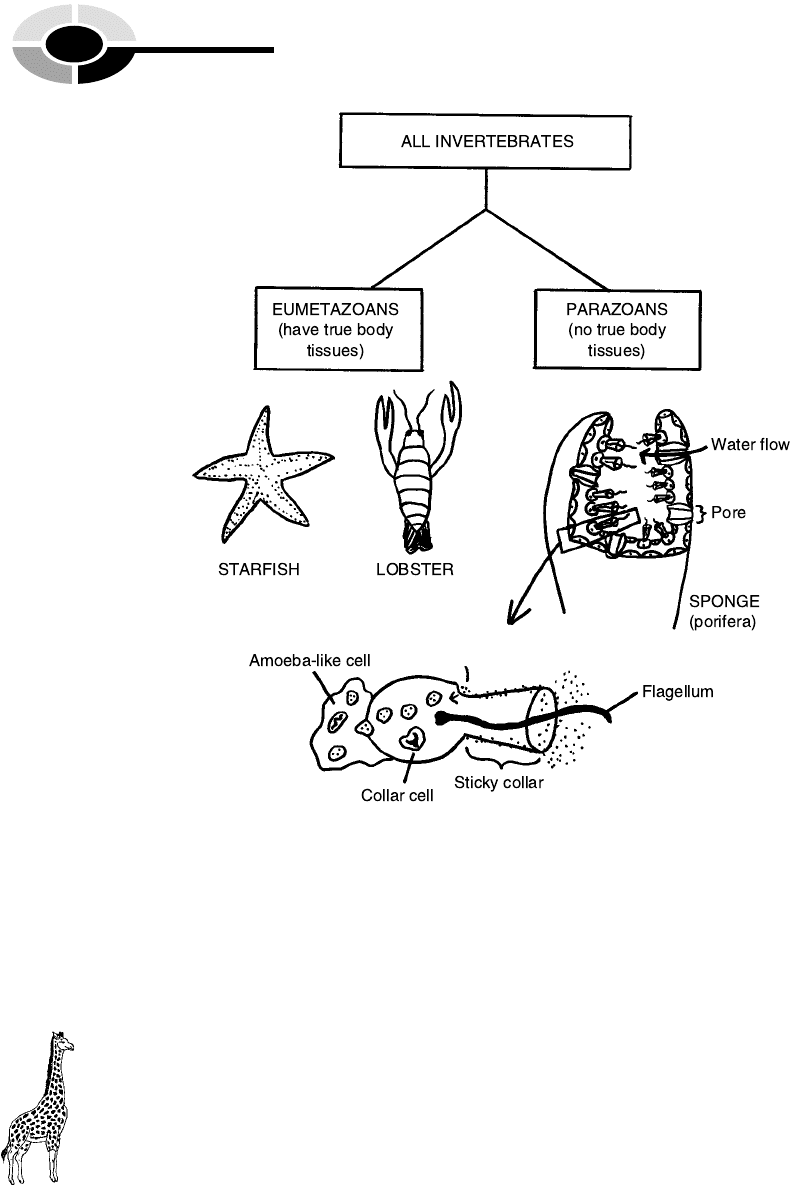
Neighboring amoeba-like cells help with the digestive process. Although the
collar cells and amoeba-like cells are different, they still do not form separate
types of tissues.
ORDERLY PATTERNS OF BODY FORM WITHIN
INVERTEBRATES
Besides lacking a backbone or vertebral column, the invertebrates display
other orderly patterns of body form. One fundamental pattern is symmetry
(SIM-et-ree). The term, symmetry, exactly translates from the Ancient Greek
to mean, ‘‘the process of measuring together.’’ In modern times, however, we
are not really referring to measuring anything (as with a ruler). Rather, we
[13:24 13/6/03 N:/4058 LAYMAN.751/4058-Alltext.3d] Ref: 4058 Layman: Biology Demystified All-text Page: 162 1-388
PART 3 Five Kingdoms of Life, plus Viruses
162
Fig. 10.1 Eumetazoans versus Parazoans: Tissues versus no tissues.
1, Order
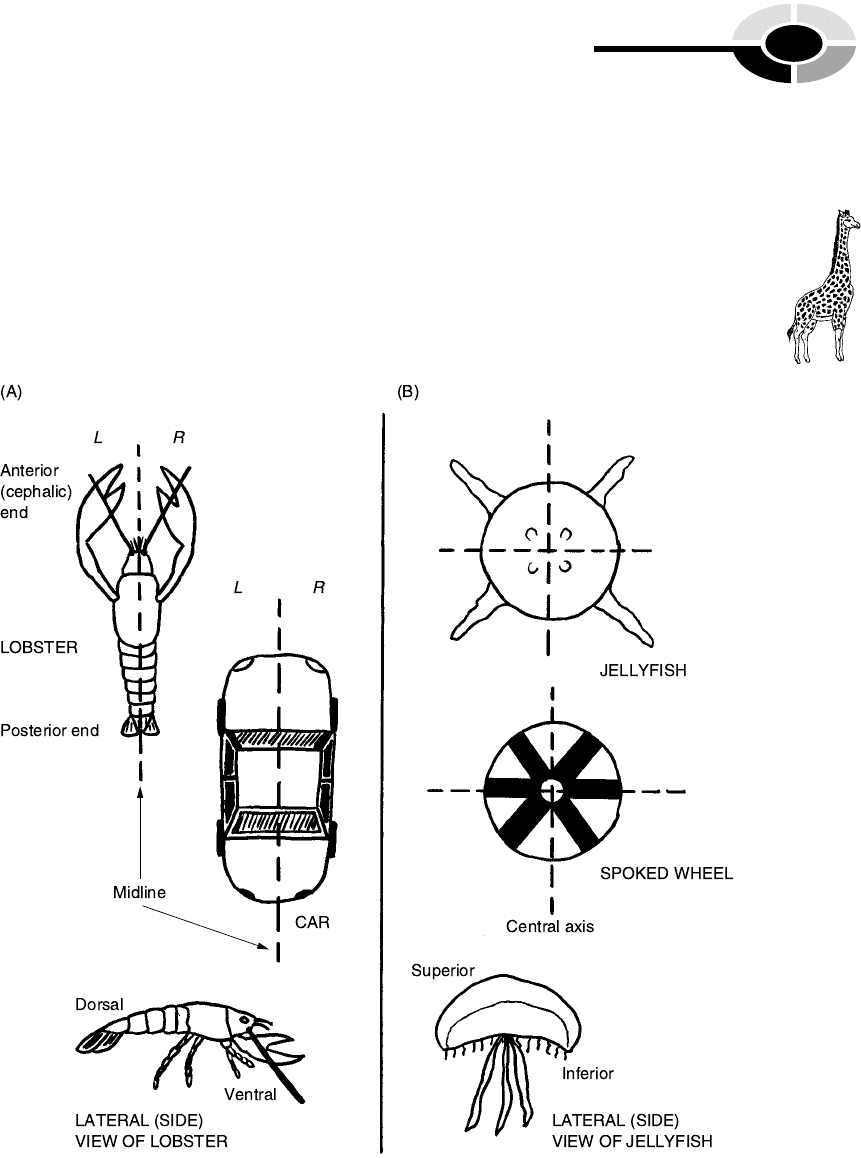
are carefully looking at the shape and size of two things, compared to each
other. Symmetry is said to be present, then, whenever there is a rough bal-
ance or equality of body shape and size, on either side of some dividing line.
Since invertebrates lack a stiffening backbone, their bodies tend to be much
more flexible than those of vertebrates. Thus, symmetry has become an
important organizing influence or pattern for their survival.
There are several specific kinds of symmetry (see Figure 10.2). The
most familiar to most people is bilateral (buy-LAT-er-al) or mirror-image
symmetry. In this type of symmetry, an imaginary line subdivides the body
CHAPTER 10 Invertebrates 163
[13:24 13/6/03 N:/4058 LAYMAN.751/4058-Alltext.3d] Ref: 4058 Layman: Biology Demystified All-text Page: 163 1-388
Fig. 10.2 Two kinds of symmetry in eumetazoans. (A) Bilateria (bilateral symmetry).
(B) Radiolarians (radial symmetry).
2, Order

into two equal halves. The right half of the body is then considered a mirror
image of the left half of the body. Consider, for example, a line drawn
lengthwise through the middle of a lobster (Figure 10.2, A). The lobster
body often has a high degree of bilateral (mirror-image) symmetry, because
the right side of the body is a mirror image of the left side, and vice versa. (By
mirror image, it is meant that both sides of the body have the same shape and
size, but that right and left are reversed.)
[Study suggestion: Get up out of your chair and go look at your reflection
in a full-length mirror. To what degree does your body and its reflection show
the characteristic of bilateral or mirror image symmetry?] An overhead view
of an automobile also often reveals a high degree of bilateral (mirror image)
symmetry.
Another important type of rough balance is called radial (RAY-dee-al)
symmetry. In radial symmetry, there is a rough balance of various parts
or ‘‘rays’’ (radi) that come out from the same center or axis. [Study sugges-
tion: Picture the sun and its rays, which make a radial symmetry.] Consider,
for example, the identical tendrils or arms of a jellyfish, which seem to radiate
(RAY-dee-ate) out from a central axis in the middle of its body (Figure 10.2,
B). The jellyfish, therefore, has radial symmetry. This makes it somewhat
resemble a wheel with a central hub, around which a series of spokes radiate.
ANATOMY OF THE BILATERIA VERSUS THE
RADIOLARIANS
Animals with a bilateral symmetry body plan are technically called the bila-
teria (buy-lah-TEER- ee-uh), or ‘‘two-sided’’ animals. The bilateria (bilateral
animals) include most vertebrates, as well as many invertebrates. They have
more to their body plan than just left and right sides. Bilateria have a head or
anterior (an-TEER-ee-or) end, that lies in ‘‘front’’ (anteri-). And they have a
tail or posterior (pahs-TEER-ee-or) end, that follows ‘‘behind’’ (posteri-).
Since the bilateria have a ‘‘head’’ or cephalic (seh-FAL-ik) end to their bodies,
we say that they show the characteristic called cephalization (sef-uh-luh-ZAY-
shun). By cephalization, it is meant that an animal has a definite head end to
its body, usually containing the main collection of its sensory organs (such as
the brain and eyes and sound detectors).
Further, the bilateria have an upper or dorsal (DOOR-sal) side in their
‘‘back’’ (dors), as well as a lower or ventral (VEN-tral) side on their ‘‘belly’’
(ventr).
Another main group of invertebrates are the radiolarians (ray-dee-oh-
LAIR-ee-uns) – creatures with ‘‘little rays’’ (radiol) or spines projecting out-
[13:25 13/6/03 N:/4058 LAYMAN.751/4058-Alltext.3d] Ref: 4058 Layman: Biology Demystified All-text Page: 164 1-388
3, Order
PART 3 Five Kingdoms of Life, plus Viruses
164
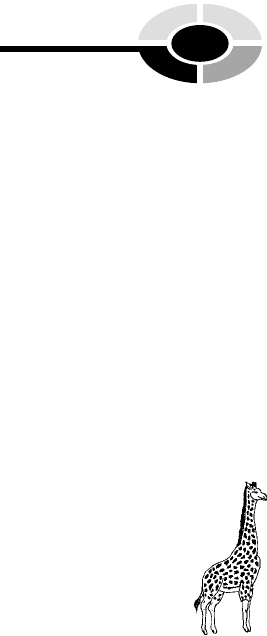
ward from their bodies. The jellyfish with its many radiating arms, of course,
is a typical radiolarian. In these animals, there is no head or rear end, nor left
or right side. They do not show the characteristic of cephalization. There is,
however, both a superior (soo-PEER-e-or) portion of the animal lying
‘‘above’’ (superi) most of the body, and an inferior (in-FEER-e-or) portion
lying ‘‘below’’ (inferi). (Go back and review Figure 10.2 to see these terms of
relative body position.)
PRESENCE OF GERM LAYERS WITHIN THE EMBRYO
In sponges (the parazoans), there are no tissues, so the embryo does not form
cell layers during its body development. In all animals except sponges, how-
ever, there are two or more germ layers – rings of cells within the embryo
from which specialized tissues and organs are produced. The germ layers are
created in several stages during the maturing of a zygote after fertilization
(Figure 10.3).
After several cleavages (successive cell divisions by mitosis), an eight-cell
stage is followed by a blastula (BLAS-tyoo-lah), a hollow ‘‘little bladder’’-like
ball of cells. The central cavity within the middle of the blastula is called the
blastocele (BLAS-toh-seal).
Following the blastula is a gastrula (GAS-true-lah). The gastrula is lit-
erally a ‘‘little stomach’’ (gastrul) or hollow ball of several layers of germ
cells. It is these germ cells (or germ layers) that eventually give rise to the
specialized tissues in the later embryo and, finally, the adult stages of life.
The gastrula is created by an infolding of the layer of surface cells around
the blastula. This infolding creates another cavity, called the archenteron
(ark-EN-ter-ahn) – the ‘‘beginning’’ (arch) form of the ‘‘intestine’’ (enteron).
The archenteron (like the mature intestine) is connected to the surface by
an opening.
Around the archenteron is the endoderm (EN-doh-derm). The endoderm is
an ‘‘inner’’ (endo-) ‘‘skin’’ (derm) of germ cells from which the lining of the
intestine and interior of other major body cavities, eventually develops. An
ectoderm (EK-toh-derm) – ‘‘outer’’ (ecto-) ‘‘skin’’ – covers the surface of the
embryo. The ectoderm ultimately gives rise to the skin and the central nervous
systems of many types of animals. Finally, most eumetazoans have a third
germ layer, the mesoderm (ME-soh-derm) or ‘‘middle skin,’’ sandwiched in
between the endoderm and the ectoderm. The mesoderm forms the muscles
and most other organs.
Various radiolarians besides the jellyfish – such as the hydras (HIGH-
drahs), sea anemones (ah-NEM-oh-nees), and coral animals – lack a meso-
CHAPTER 10 Invertebrates 165
[13:25 13/6/03 N:/4058 LAYMAN.751/4058-Alltext.3d] Ref: 4058 Layman: Biology Demystified All-text Page: 165 1-388
4, Order
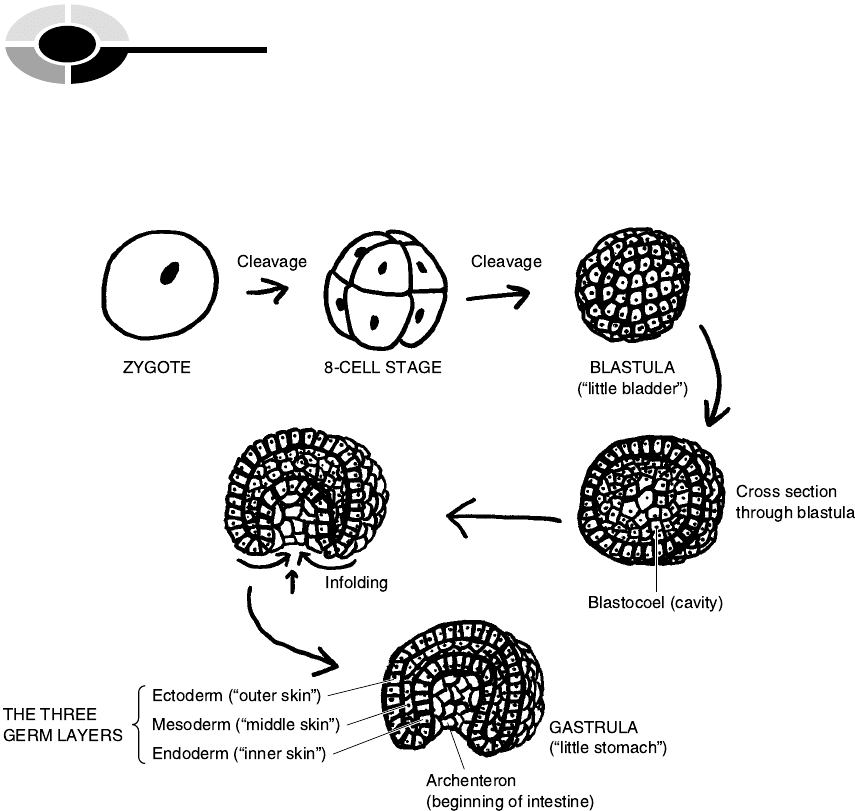
derm. But they still have the other two germ layers, the endoderm and
ectoderm, from which all of their adult tissues eventually develop.
Coelom or No Coelom: Body Cavities in the
Bilateria
Having discussed the sponges (parazoans) without tissues, as well as the
radiolarians (eumetazoans with tissues and radial symmetry), we will now
focus exclusively upon the bilateria. Remember that the bilateria are eume-
tazoans with true body tissues, as well as mature bodies that have the form of
bilateral symmetry. These mature bodies grow from embryos having all three
germ layers.
[13:25 13/6/03 N:/4058 LAYMAN.751/4058-Alltext.3d] Ref: 4058 Layman: Biology Demystified All-text Page: 166 1-388
PART 3 Five Kingdoms of Life, plus Viruses
166
Fig. 10.3 The three germ layers in the embryo.
